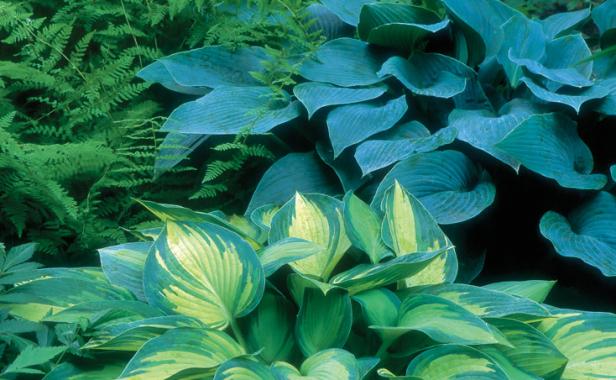
When I began growing hostas, I used the plant’s size to determine where I placed it in my border. I didn’t think about how the hostas interacted with each other or with the annuals and perennials around them. One day, I replaced a green-and-white hosta growing near a yellow daylily with a gold-variegated one. I was amazed by how much the color echo between the gold foliage and the yellow flower improved my design.
As easy as hostas are to grow, they can be a bit tricky to work into a design, especially if you want them to be the star attraction. I’ve noticed that a plain, common hosta can look stunning when it is planted among the right plants and an expensive, showy hosta can look disappointing when it clashes with its neighbors.
The key to getting the most from your hostas is using the concepts of balance and accent as you weave them into your garden design. Balancing the colors and sizes of your hostas will help them work with the rest of your design. Accenting them with the appropriate companion plants will help them get the attention they deserve.
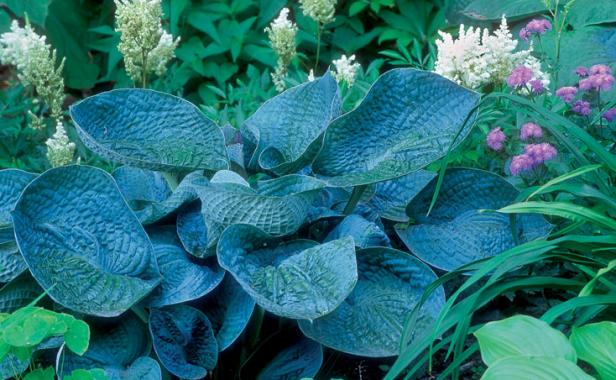
Avoid too many brightly colored hostas

One common mistake gardeners make when designing with hostas is to try to create interest with a heavy use of showy gold or variegated hostas. Because these plants pop out at you, too many of them make a garden seem chaotic rather than harmonious. To balance your design, use mainly green, blue, or subtly variegated hostas. It’s easy to balance these hostas because they are unlikely to clash with other plants around them or clamor for attention. You can use green, blue, and lightly variegated hostas almost anywhere to support other plants, add structure, and make the garden lush. These hostas have a quiet presence. The more of them you have, the more restful your garden will be.
Another reason strongly variegated or yellow hostas can be hard to design with is because they catch and hold the eye. Most hostas with white variegation make great focal points, but not all gold hostas do. The brightness of their leaves depends greatly on how much sun they get. In full shade, gold hostas tend to turn chartreuse. They are at their best when grown in morning sun because it provides enough light for their gold color to develop without scorching their leaves.
Use flowers to accent hosta leaves
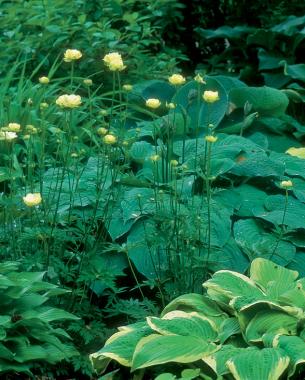
Working with color is one of the most exciting aspects of designing with hostas because their leaves range from sharp white or brilliant yellow to silvery blue or near-black green. These colors become even more striking when you accent them with other plants. Once you start doing this, you’ll be amazed at the improvement in your designs.
Color has a magical way of tying plants together so that the eye flows from one to the next. An unremarkable, solid-colored hosta suddenly becomes beautiful because its color is enriched by a neighboring plant. A blue hosta, for example, looks great planted among pink and purple flowers. The leaf color of a gold hosta becomes more intense when it is echoed by yellow flowers or contrasted with purple flowers. Even if a plant has just a small splash of the color you want to echo, it will be effective. For instance, a daylily with a yellow throat will enhance a gold hosta.
The most striking combinations include variegated hostas because providing a color accent emphasizes the amazing foliage patterns. White flowers make white-variegated leaves look sharper, and yellow flowers make the gold variegation on hostas look brighter. It’s that simple.
Most shady perennials like astilbes (Astilbe spp. and cvs., USDA Hardiness Zones 3–8) and meadow rues (Thalictrum spp. and cvs., Zones 3–10) are excellent color companions for hostas, but they bloom only for a few weeks. Use shade-tolerant annuals like impatiens (Impatiens walleriana cvs.), nicotiana (Nicotiana spp. and cvs.), browallia (Browallia speciosa and cvs.), torenia (Torenia fournieri and cvs.), and coleus (Solenostemon scutellarioides cvs.) for season-long color and the opportunity to try different color combinations each year.
Certain situations call for specific hostas
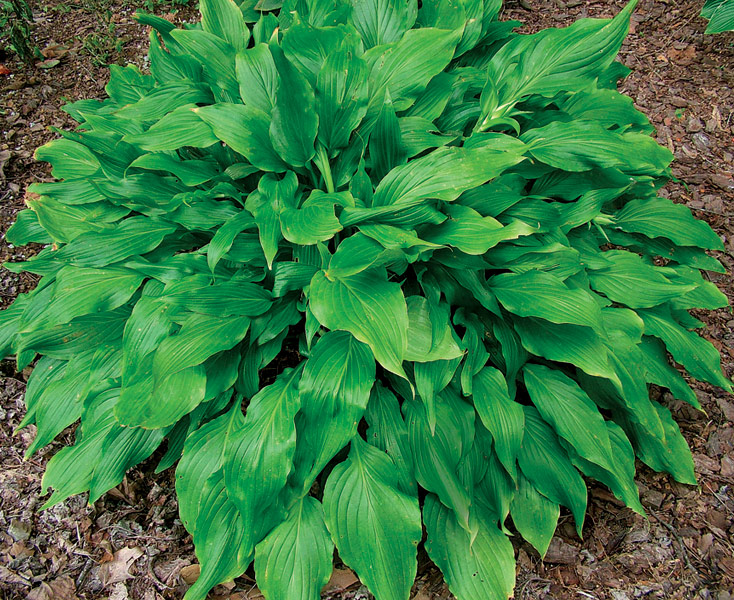
Photo/Illustration: courtesy of the Gardens of Sunshine Hollow
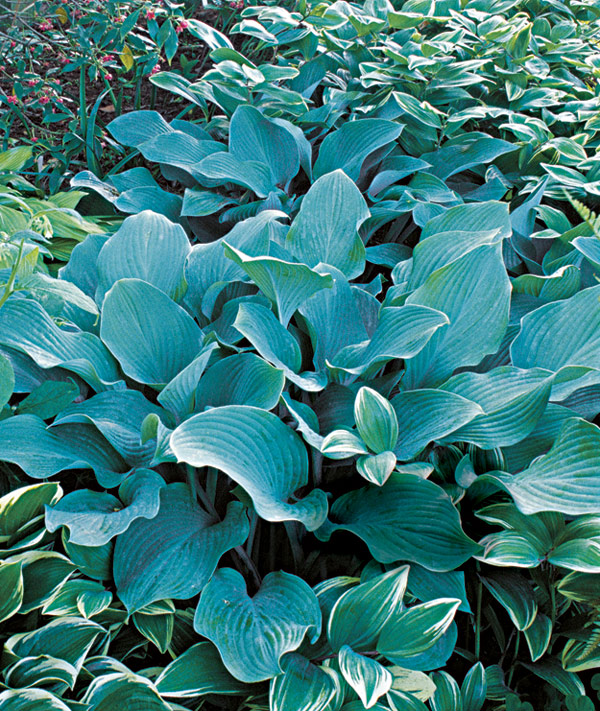
Photo/Illustration: Todd Meier
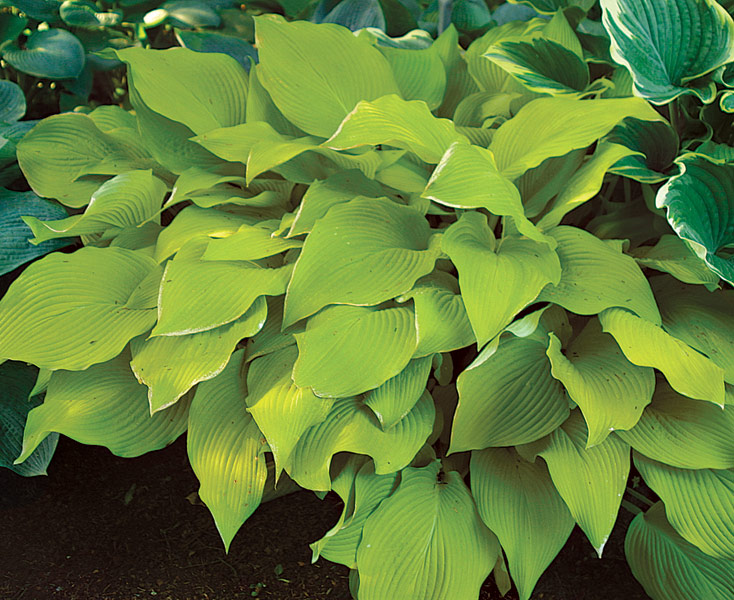
Photo/Illustration: Jennifer Benner
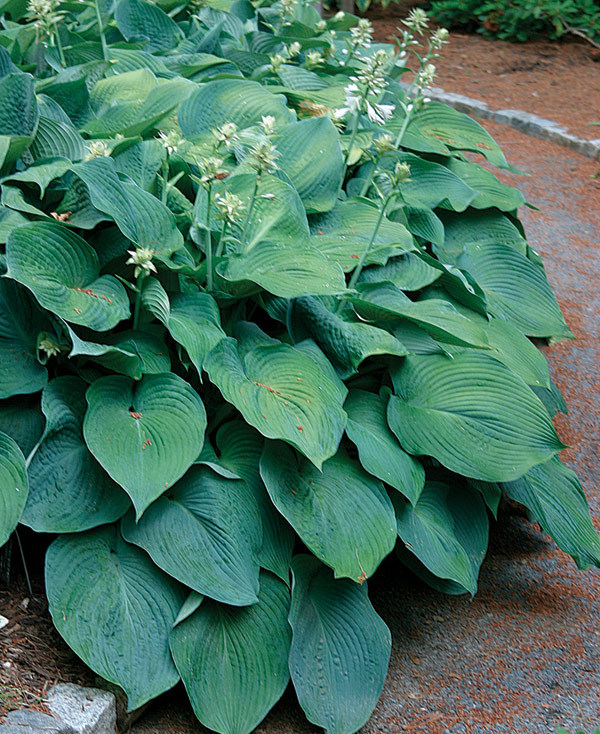
Photo/Illustration: Michelle Gervais
On a slope or near a pond or stream
Consider hostas that have a distinctive cascading form like ‘Green Fountain’, ‘Niagara Falls’, ‘Jade Cascade’, or ‘Permanent Wave’ to draw the eye down a hill or to a water feature. Hostas with leaves that have a white underside, like green ‘Maekawa’ or blue ‘Azure Snow’, are more striking when you can look up at them.
Near a tree or post
Select one of the many beautiful vase-shaped hostas to accent vertical elements in the landscape. Their upright form helps link the lower-growing plants to the tree or structure. Some of the best include ‘Krossa Regal’, ‘Regal Splendor’, ‘Sagae’, ‘Sun Power’, and Hosta nigrescens.
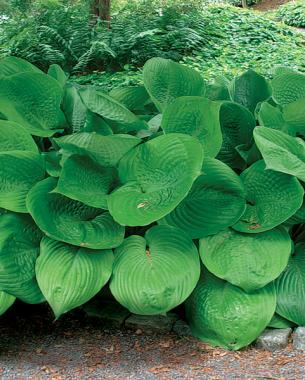
Photo/Illustration: Michelle Gervais
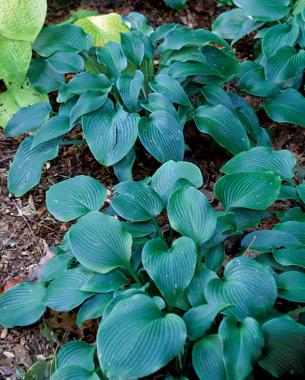
Photo/Illustration: Michelle Gervais
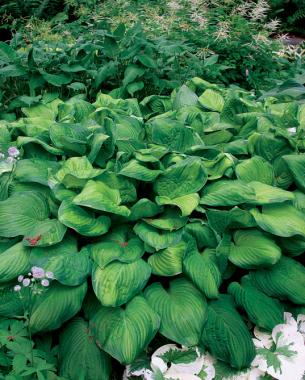
Photo/Illustration: Michelle Gervais
In slug-prone areas
If you have wet areas that are infested with slugs, plant thick-leaved hostas because they are more resistant to slug damage. These hostas also tend to hold up better under adverse conditions, so they look good all season. Try Hosta sieboldiana var. elegans, ‘Blue Angel’, ‘Sum and Substance’, ‘Sagae’, ‘June’, ‘Halcyon’, or ‘Inniswood’.
Near a path or bench
In areas that invite lingering or close inspection, use hostas that are best appreciated up close. ‘Pandora’s Box’, ‘Baby Bunting’, ‘Raspberry Sorbet’, and other small varieties are good candidates. Or choose fragrant-flowered hostas like Hosta plantaginea, ‘Guacamole’, ‘Fragrant Bouquet’, ‘Fragrant Blue’, and ‘So Sweet’.
One hosta can complement another
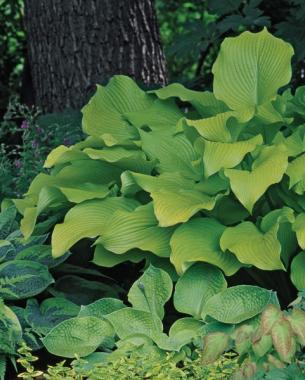
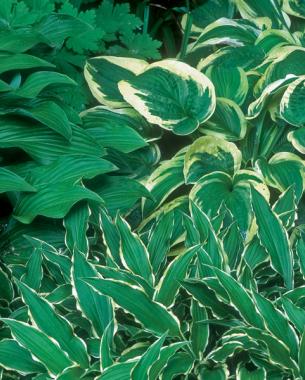
It’s easy to succeed with hostas, and once you’ve grown one, you’re likely to get drawn in by the many varieties available. But putting a lot of hostas together can raise design challenges because the hostas can clash with each other or they can create an uninteresting group. Ideally, if two hostas are close together, one should complement the other. A simple design trick is to use a solid-colored hosta to echo a color in a variegated one. For instance, you might place a gold hosta next to a gold-variegated hosta or a green hosta next to a green-and-white-variegated hosta.
Avoid planting a bold, white-variegated hosta near a solid gold or gold-variegated one because they will compete for attention. Each needs its own territory, so place them away from each other and surround them with green or blue hostas and other plants with soothing foliage.

The leaves of many gold hostas, especially when they are grown in some sun, are brighter than the leaves of blue and green hostas. While your eye will pass easily over dark foliage, it will be drawn to the fabulous bronze color of a gold hosta. So if gold hostas are scattered around the garden, they will look like yellow dots, making the garden appear busy. Instead, place them in small groups to create drifts of gold. The eye will then move easily from one to the other because they are linked by color and planted close together.
There is wide color variation among gold hostas, and some may look better together than others. You may have to experiment to find pleasing combinations.
You can also combine hostas with the same leaf color, but make sure they differ in another characteristic. If you want to plant two blue hostas close to each other, select one that has large leaves and one that has small leaves. Or try one that has heart-shaped leaves with one that has long, lance-shaped leaves. If hostas are too much alike, they will look boring together, but if they have nothing in common, they will merely look like isolated plants.
The best combinations feature hostas different enough to be interesting yet similar enough to look like they belong together.
Use fine textures to balance hostas
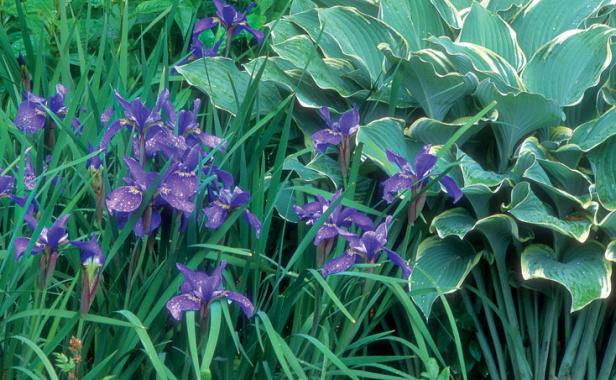
Because most hostas form a dense mound of cascading leaves, they have a heavy, solid look that should be made lighter by fine-textured companions. What could be more dramatic than a lacy maidenhair fern (Adiantum pedatum, Zones 3–8) resting against a hosta with thick, corrugated leaves? The contrast in size makes the hosta look even bolder. The garden then becomes more engaging because one wants to pause and look more closely at the interaction between the two plants.
Ferns are the best fine-textured companions for hostas in deep shade. If the hostas are growing in partial sun, astilbes, goatsbeards (Aruncus dioicus and cvs., Zones 3–7), and bugbanes (Cimicifuga spp. and cvs., Zones 3–8) can balance the hostas’ coarse foliage.
Don’t forget to include plants with medium texture to help knit the fine-textured plants and hostas together. In shade, use epimediums (Epimedium spp. and cvs., Zones 5–9), Solomon’s seals (Polygonatum spp. and cvs., Zones 3–9), and bigroot cranesbills (Geranium macrorrhizum and cvs., Zones 4–8). In partial sun, you’ll have a choice of many more perennials including daylilies (Hemerocallis spp. and cvs., Zones 3–10) and martagon lilies (Lilium martagon, Zones 3–7).
As you play one hosta off another and set them among other plants that make them look their best, you’ll soon discover how easy it is to create beautiful combinations. Balance and accent are simple ideas, but they will transform your garden and make you feel like an artist.

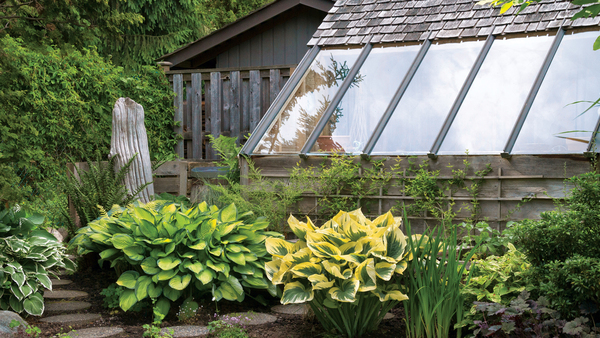
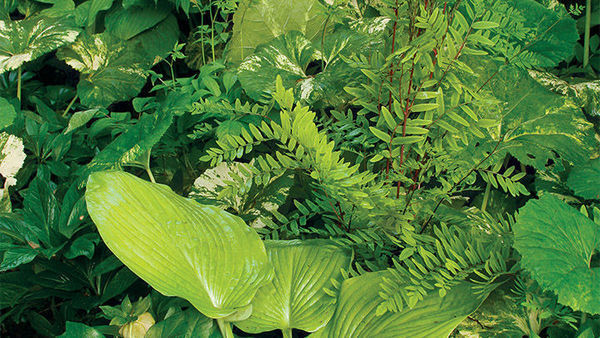
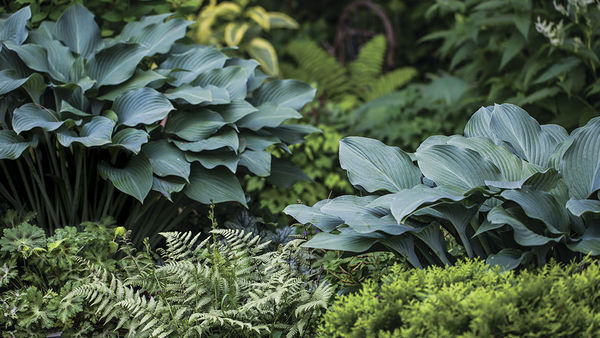
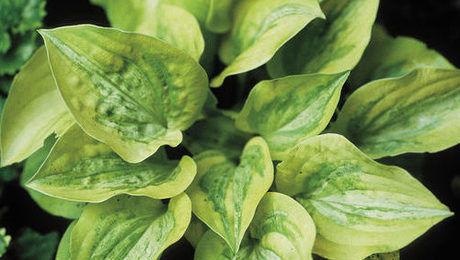
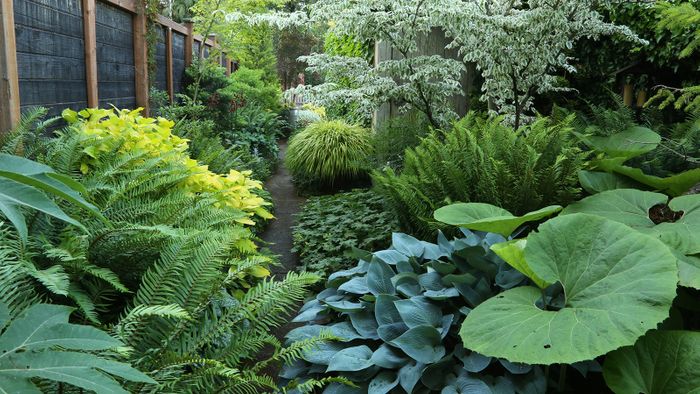
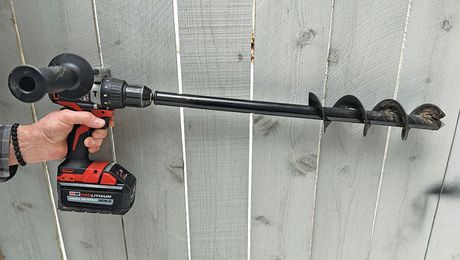






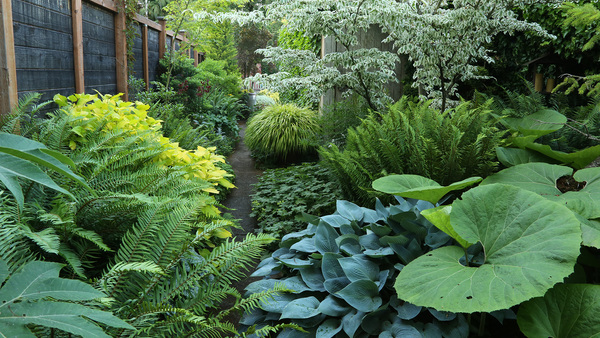



Comments
I was on your website and reading your blog. You have shared informative blog for everyone dvd player windows i hope you sure like this dvd player.
I love it...........The difference in size makes the hosta look significantly bolder. The greenhouse at that point turns out to be all the more Cheap Essay Help captivating in light of the fact that one needs to delay and look all the more carefully at the association between the two plants.
I think at last you need your significant other to characterize what unclean plants gardens resemble. Investigate Shawna Coronado, she's huge into urban
nourishment yards that are at Online Digital Marketing Agency brilliant, consumable and have a perfect format
Great garden design and especially your tips are really helpful I'm new as a plant lover and planning to make a garden into my office and you can Wikipedia page creation services for your website it will help you grow your networks
Good ideas and design about gardening, your blog name is truly good. You Should take Wikipedia page creation service for your business.
As far as I might be concerned, a gigantic storeroom in every room, a huge wardrobe/storage space in the kitchen, an enormous storage units bristol room in the pantry, and a decent estimated cloth wardrobe are great. I likewise have a china bureau incorporated into the divider. That might be it!
Nice catchy topic, and you have some great gardening design ideas. For your brand, you ought to use a service to professional wikipedia services.
Its a nice topic. I like your gardening ideas.
http://www.topviewcreators.com
Thank you for making this so clear, i really found this article very enlightening South Africa music: - Fakaza songs
Get the Latest Fakaza Mp3 Download on all Amapiano songs
Log in or create an account to post a comment.
Sign up Log in